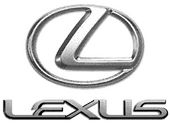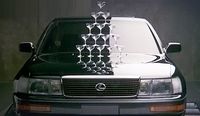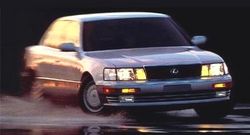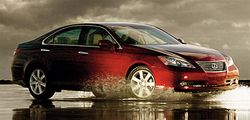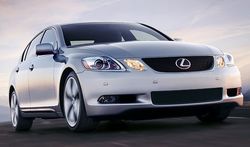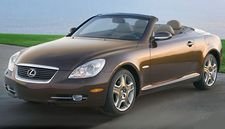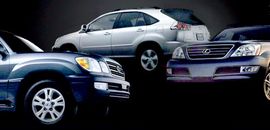.
Lexus
Search By Model | |
| 2012 Current Models | |
| Near-Luxury Car | |
| IS 250 | |
| IS 350 | |
| ES 350 | |
| Mid-Luxury Car | |
| GS 350 | |
| GS 460 | |
| Ultra-Luxury Car | |
| SC 430 | |
| LS 460 / LS 460 L | |
| Luxury SUV | |
| GX 460 | |
| LX 570 | |
| RX 350 | |
| Hybrid | |
| LS 600h / LS 600h L | |
| GS 450h | |
| RX 400h | |
| CT 200h | |
Lexus is the luxury automobile division of Toyota Motor Corporation. The Lexus brand name represents a premium line of luxury vehicles, first begun in 1989 with the debut of the LS 400 flagship sedan and the ES 250 executive sedan. Lexus cars and SUVs are sold in North America, the Middle East, Europe, Africa, Latin America, Asia and Oceania; in the United States, Lexus is the top selling brand of luxury cars. Until 2005, Lexus vehicles were sold under the Toyota marque in Japan until its introduction there that year.
The Lexus line of luxury vehicles was started in 1989 to compete with other luxury makes, including German firms Mercedes-Benz, BMW, and Audi; Cadillac and Lincoln in the U.S., and Honda's Acura division. Before the first Lexus sedan premiered at the 1989 Detroit Motor Show, Toyota engineers spent five years in secret development, costing billions of dollars and involving over 150 prototypes built for a testing process unprecedented in Toyota's 50-year history. The crowning result was the LS 400 flagship sedan, a vehicle which was more aerodynamic, more quiet, and more efficient than its rivals. To the customers that bought them, the LS 400 was regarded as a better value than its higher-priced competition,<ref>Lexus LS Generations</ref> and within two years Lexus had become the top-selling luxury import in the U.S.
Since its successful introduction, Lexus has developed a reputation for quality and customer service. In the U.S. the brand continually ranks at the top of owner satisfaction and reliability surveys. Today, over 16 years since the company's debut, many LS 400 sedans continue operating capably for their owners, a testament to the engineering expertise that went into the Lexus flagship model. In recent years, Lexus' sales have been propelled by a successive series of popular designs. In 2006, the Lexus line had three of the top 10 best-selling luxury vehicles in the U.S.—the RX, ES, and IS—more than any other luxury make.<ref>Best-Selling Luxury Cars 2006</ref>
Lexus History
The Lexus saga began in 1983, when Toyota began the F1/Circle-F project, a secret initiative to develop the "world's best luxury car." This project was inspired by the success of the Toyota Supra sports car and the luxury Toyota Cressida models. Both the Supra and Cressida were rear-wheel drive cars with a powerful 7M-GE/7M-GTE engine. For their new flagship vehicle, however, U.S. Toyota executives convinced the Japanese Toyota board that a separate brand and dealership network was needed to support a top-flight luxury vehicle in the world's largest automotive market, the United States. Additionally, such a network would require not just one model, but several, the executives suggested. After much debate, Toyota's Japanese leadership agreed to launch a separate luxury division. Initially, some Japanese Toyota executives were affronted with the prospect of their most prized design getting a separate badge, but ultimately they agreed that a separate title would confer a more lofty status.
The Lexus division
An image consulting firm presented a list of 219 names, from which Vectre, Verone, Chaparel, Calibre and Alexis were top candidates. While Alexis quickly became the front runner (possibly due to the association with the Alexis Carrington character on the popular 1980s primetime drama Dynasty) and later morphed to Lexus, the name has been attributed to the combination of the words "luxury" and "elegance." According to Toyota, however, the name had no meaning and was just meant to be pleasing and easy to remember. Just prior to the release of the first vehicles, the database service LexisNexis obtained a temporary injunction forbidding the name Lexus from being used as they stated it might cause confusion. Upon reflection, the court lifted the injunction, deciding that there was a low likelihood of confusion between the two products. Another theory has surfaced, claiming that the Lexus name was given to the project by Toyota in the mid-80s, as an acronym for Luxury EXport United States. with the acronym "LEUS" with the "x" from "luxury" added to form "Lexus". Hunter Communications and Molly Designs created the "L" logo that became the symbol of the Lexus line.
The Lexus slogan, developed after U.S. personnel visited Lexus designers in Japan and noted their obsessive attention to detail, became "The Relentless Pursuit of Perfection."
Launch of Lexus
The first Lexus-badged models, the V-8 powered LS 400 and the smaller, Toyota Camry-based ES 250, appeared in 1989. The LS 400 flagship captured most of the attention; it had a unique design, sharing no major elements with previous Toyota vehicles, with a new 4.0 L V8 engine. It was widely praised for its silence, well-appointed interior, fine engine performance, outstanding build quality, and value. (In some markets, it was priced against mid-sized Mercedes-Benz and BMW models, while offering size, performance, and quality comparable to their full-size cars). It was generally regarded as a major shock to the European marques, but was criticized by automobile columnists for anonymous styling and a suspension regarded as too compromising of handling for ride comfort. Nonetheless, the LS 400 won several major motoring awards when released, including Wheels magazine's Car of the Year and Best Imported Car of the Year by the Motoring Press Association.
The Lexus marque was fully launched in the United States in late 1989. Lexus launched later in Great Britain, Canada and Australia, in 1990. In some countries, like Malaysia, New Zealand, Ireland, and the UK, where there is a market in grey imports of Japanese cars, some equivalent Toyota models were retro-fitted with Lexus badges, although they still differ slightly from officially imported Lexus models, especially in specification and equipment levels. Lexus launched later in Australia, New Zealand, Malaysia, South Korea, Taiwan, and other European countries.
Global expansion
Today, Lexus has become the fourth-largest luxury make in the world, by volume. Lexus directly competes with such luxury brands as the Europe's Audi, BMW, Jaguar, Mercedes-Benz, Porsche, and Volvo, the American Cadillac and Lincoln, and Japanese brands Acura and Infiniti. In the U.S., Lexus' success can be attributed in large part to its excellent reputation for reliability and customer service; the luxury line consistently ranks at the top of J.D. Power and Consumer Reports surveys; similarly, Lexus vehicles rank at the top of Auto Express and Top Gear automotive surveys in Europe.
The Lexus marque was finally introduced to the Japanese market on July 26, 2005. The compact IS 250/IS 350, convertible SC 430, and midsize GS 350/GS 430 will all be available in Japan in the 2006 model year. As of June of 2006, all but two of the 130+ Lexus dealerships in Japan were in the red. In a country where Accords and Camrys are considered quite luxurious, and where its existing lineup already has 45% market share, Toyota has a long way to go to expand Lexus to match the success of BMW and Mercedes Benz in the luxury segment. Fortunately, the lowest cost and most efficient automaker in the world has the biggest war chest and can afford to pay its 1,000s of Lexus employees to wait around. In late 2006-2007, the Lexus lineup in Japan gained a significant boost with record-setting orders for its new LS 460 flagship sedan, which debuted in September.
L-Finesse
As part of its expanded global launch and bid for luxury market leadership, Lexus' new offerings, released between 2004 and 2007 all carry its new, distinctive design language - dubbed L-Finesse. Lexus is finally taking visuals and aesthetics seriously, after years of being dismissed as being a producer of bland and lacklustre designs. Following in the footsteps of BMW's Bangle inspired design (but avoiding much of the controversy), The L-Finesse design language is the product of an increasingly competetive auto market, where only the most outstanding and flamboyant vehicles attract consumer attention. Lexus' new crop of concept vehicles, which include the LF-X, LF-S, LF-C, LF-A and LF-Sh, all feature L-Finesse design cues. These vehicles can all be viewed at Lexus' official concept website, [Lexus Concept Vehicles]. The first production vehicle to feature the L-Finesse design treatment was the 3rd generation GS sedan, inroduced for 2006. This was followed a few months later by the redesigned second-generation IS, and then the new LS and ES sedans. The Lexus SUV lineup may be next in line for the L-Finesse designers. On the sedans, the L-Finesse "look" is sleek, with character lines emanating from hood to trunk; a "waterfall" effect features from the A pillars forward, and the rear cabin has a pulled-back look, often with slingshot side windows. A unifying characteristic across the entire L-Finesse sedan lineup is a trapezoid grille that is positioned slightly lower than the level of the headlamps, unlike most other car designs from other marques. Elements of the L-Finesse designs feature styling cues derived from Japanese characters.
Lexus Vehicles
Over the years, Lexus has developed a strong and complete portfolio of vehicles that covers a significant spread of the luxury market. Today, its lineup includes four sedans - IS (an entry level sports compact), the ES (an midsize luxury sedan), the GS (a sports-luxury sedan) and the LS (flagship luxury sedan). one roadster (the SC 430), and the porfolio also sports three SUVs - the RX (a crossover compact), the GX (a midsize luxury) and the LX (full size flagship).
Lexus Cars
The Lexus IS was introduced in 1998 as Lexus' answer to the BMW 3-series in the U.S. and European markets. In Japan, the first generation IS was sold as the Toyota Altezza. Although a serious automobile, experts never considered it to be a true threat to the BMW's superior benchmark. That all changed with the introduction of the second generation, 2006 model year IS - a vehicle considered to be on par with the BMW's standings. Now offered with a choice of 2.5 or 3.5 liter mills, the IS delivers serious grunt with the refinement and precision matched only by Lexus. The newest IS was introduced in Japan as part of Lexus' debut in its home country.
Lexus' entry level midsize luxury sedan, the ES, is vaguely based on Toyota's bread-and-butter Camry sedan platform, with a separately designed body style, interior, and technological features. Instead of the Camry's four and six banger engines, however, comes the stately 3.5 liter. This V6 hustles the saloon with speed - although the ES is marketed more as an elegant, luxury sedan than a sports tourer. Previous versions of the Lexus ES were direct counterparts of the Toyota Windom, which was sold in Japan. While most of Lexus' offerings are aimed squarely at the German car buyer, the ES does not have a German car counterpart, and is instead sold as a luxury sedan for those wishing a comfortable, front-wheel drive luxury vehicle without ample sporty ambitions.
The GS sports sedan has its sights aimed squarely at Germany's midsize sports sedan offerings. Armed with a choice of three engines - the base 3.5, a potent 4.6 and an incredible 4.5 Hybrid - the 2007 Lexus GS enters battle armed every bit like the German sedans it tries to embody. Unlike the Toyota Hybrid variants, which improve fuel mileage at the cost performance, the hybrid version of the GS, the GS 450h, is aimed at further boosting performance, without loosing fuel economy. With its hybrid powertrain producing around 340 HP, the GS 450h is the fastest Lexus ever built--surpassing the IS 350, the fastest conventional gasoline powered Lexus.
Lexus' spanking new flagship LS luxury cruiser is available for the 2007 model year. This vehicle offers a 4.6 liter powerplant, bringing a whopping 380 HP and 370 pound-feet of torque to the table. Power is transferred to the wheels through a groundbreaking 8 speed gearbox - a first of its kind. An extra few grand buys you the 'L' badge - Lexus' crack at the extended wheelbase sedans of Germany. And if even that is not enough, buyers have the choice to opt for the LS 600h L, the first hybrid V8 ever. Lexus claims that its flagship Hybrid will have the performance and luxury to compete with Germany's V12 sedans, while offering the relative frugality of a V8.
Lexus' only sports tourer, the SC, is a convertible hardtop. While not much of a sports vehicle, the SC 430, previously known as the Toyota Soarer in Japan (until 2006, when it was replaced by the SC 430), is certainly an elegant convertible cruiser. While the Soarer offered a twin-turbo in its home nation, only the standard induction 4.3 is offered with the SC 430. With a body design inspired by the French Riviera, the SC 430 is a stylish statement from Lexus. Until the arrival of the 2007 LS 460/LS 460 L, the SC 430 was the most expensive car in the Lexus lineup.
Lexus SUVs
So you want to enjoy the comfort and space afforded by an SUV but don't want to empty your wallet with $3/gallon fillups? Enter the crossover-ute. Lexus ups the ante in the soft roader class by introducing the new and improved RX. Based on the Camry platform, the RX can be had with a 3.5 liter internal combustion engine, or a hybrid - dubbed the RX 400h. The RX is considered one of the first crossover SUVs, and the first one built for the luxury market. It has spawned dozens of competitors, but none approach the success of the RX--Lexus' top-selling model and the best-selling luxury vehicle in America in 2004 and 2005.
Customers shopping for a standard, body-on-frame SUV can also stop by to check out the new GX, known elsewhere as the Toyota Land Cruiser Prado. Available as a five or seven seater, this midsize SUV is Lexus' answer to America's burgoening SUV market. Notable for its extensive 4x4 capabilities, the GX 470/Prado is operated and raced by Toyota and other 4x4 teams the world over.
Lexus' final entree in its portfolio is the LX. Based closely on Toyota's Land Cruiser, the LX 470 comes to the Lexus dealership donning a new badge, reworked interiors and a greater level of sophistication. The LX 470 will be succeeded by the all-new LX 570, which premieres at the New York International Auto Show in April 2007.
In the Pipeline
The 2007 model year marks the finish of Lexus' current batch of lauches, with the arrival of the highly anticipated LS. However, possibly two brand new models and other variants loom on the horizon (such as a possible coupe/convertible version of the IS, and successor models to the RX and SC model lines).
The first all-new model is the Lexus JX, Lexus' foray into the full size SUV market. Based on the upcoming Toyota Sequoia/Tundra platform, the JX will go head to head with similar offerings from Lincoln and Cadillac. Unconfirmed rumors have it that the JX will come to the US not with the standard 4.7 liter mill, but with a more potent 5.4 liter mill.
Finally, Lexus' display of its LF-A concept at the Detroit Auto Show hints at a production version of its sports coupe. Lexus' bias towards fuel economy, soft suspension settings and silent engines had meant that experts rarely took Lexus' attempts at sportiness seriously. The LF-A is all about changing those perceptions. Lexus has recently announced that the LF-A will walk into dealerships wearing a V-10 rated at over 500 bhp in a sub-5 liter engine. A vehicle that reportedly will push the 200 mph barrier clearly shows that Lexus is taking 'sport' seriously. The LF-A may come to market as the Lexus GT 450.
In January 2007, Lexus announced a new performance division, F-Series, which would produce racing-inspired versions of its luxury performance vehicles. The first F-Series vehicle, the IS-F, made its debut at the 2007 North American International Auto Show, accompanied by an exotic F-Series supercar concept, the LF-A F. The Lexus F-Series vehicles will rival the high-performance lineups of the leading European and American luxury marques.
Production
Many Lexus vehicles are manufactured in the Tahara, Japan plant, a highly sophisticated, computerized manufacturing plant, awarded the title of the best automobile manufacturing plant in the world.<ref>Tahara given JD Power Platinum Award, fewest defects anywhere in the world</ref> Lexus manufacturing techniques include methods and standards of quality control that differ from Toyota models. At the Tahara plant, separate assembly lines were developed for the manufacture of Lexus vehicles. New molds and specialized manufacturing equipment were also developed for the Lexus production process. Welding processes, body panel fit tolerances, and paint quality requirements are more stringent for Lexus models. Each production Lexus vehicle is also given an extensive visual inspection for flaws and subjected to vibration tests to ensure a smooth and quiet ride.
The North American-market RX 350 (since the 2004 model year) is produced in the city of Cambridge, in Ontario, Canada, and is the first Lexus plant located outside of Japan. Lexus vehicles are also produced at the Araco, Kanji (Iwate), Kanji (Kanto Jidosha), Katashiki, Kyushu, and Tahara plants in Japan.
Service
Lexus has become known for efforts to project a luxury image even with service provided after the sale. The waiting areas in the service departments are complete with such amenities as a refreshment bar, business center that is soundproofed and stocked with computers and a fax machine, and the service bay is lined with large picture windows to allow the customers to watch the repairs. Other amenities can include a children's play area, indoor putting green, and other recreational services. Recently, several Lexus dealerships have added on-site cafes and designer shops.
In 2005, Lexus came first in the Top Gear Survey, "the UK's biggest independent car satisfaction survey" with over 76,000 respondants. In 2006, Lexus ranked first for the eleventh time in J.D. Power's Customer Service Index, its annual study involving over 79,000 U.S. owners and dealership experience. In 2006, the Luxury Institute, New York, rated Lexus #1 in Customer Experience among luxury automobile brands based on its survey of over 2,100 high-income households. On the strength of its customer service standards and high product satisfaction, Lexus enjoys one of the highest customer loyalty rates in the industry.
Motorsport
Lexus has been participating in endurance racing, in particular the Rolex 24 Hours of Daytona. Since entering the series in 2004, Lexus has won over 15 Rolex Series event races. In 2005, Lexus was runners-up and in 2006 it won the championship. Although Toyota has won this prestigious race in the past it was the first time that its luxury arm emerged as the winner. In 2007, six Lexus-powered Daytona prototypes were entered in the Rolex 24 Hours of Daytona event at the Daytona International Speedway. Lexus was a repeat winner of the event, with a Lexus-Riley prototype driven by Scott Pruett, Juan Pablo Montoya, and Salvador Durán of Chip Ganassi Racing finishing first; Lexus-Riley prototypes also took three of the top ten spots.
Lexus is also going to participate in 12 Hours of Sebring which now form a part of American Le Mans. There has been speculation of a Lexus F1 operation in the near future, in line with its expansion into the luxury car markets, and increasing competition with BMW and Mercedes-Benz. Lexus may enter for the 2007 Formula 1 season as an engine supplier to the WilliamsF1 team, using Toyota engines rebadged as Lexus, but these rumors are purely speculative.
After the release of the Lexus brand on the Japanese Domestic Market (JDM) in 2005, four SC 430 coupes were entered in the SuperGT series in the GT500 class. In the first race of the 2006 series, an SC 430 took the chequered flag. In 2006, Lexus raced a hybrid vehicle for the first time, entering a GS 450h performance hybrid sedan in the Tokachi 24-hour Race in Hokkaido, Japan.
Future of Lexus
Although Lexus has had phenomenal success in the US since 1991-1992 — within 3 years of its introduction in 1989 — it has been struggling outside North America, including its home country, Japan, where the Lexus brand started marketing in 2005 and is still waiting for the arrival of the LS series due later this year, and in particular Europe. Automotive analysts have pointed out that Lexus has been so successful in North America because the wide consumer base of Toyota and in particular the baby boomers wanted something more luxurious as they were becoming older and their surplus incomes were allowing them to migrate to brands such as Mercedes-Benz and BMW. The huge success of Lexus was in part due to the fact that its higher levels of quality and cut-rate prices enabled it to retain those migrating customers and keep them "in the family."
However, this also had negative repurcussions as Lexus gradually cemented an image of cut-rate brand, which would offer similarly equipped cars at tens of thousands of dollars less than its primary competitors, Mercedes-Benz and BMW. The former chief of BMW, Eberhard von Kuenhiem predicted that this strategy would work to some extent in US, but not in Europe, where the words premium and luxury do not go well with cut-rate pricing. Some automotive experts believe that Lexus' failure to woo European customers and its very slow incremental increase in European arena is because of the serious damage Lexus has done to its brand image. This has led some automotive thinkers to believe that unless Lexus prices its products head-to-head with the European premium brands and emphasizes its superior quality, reliability and engineering, it will not be able to succeed globally.
However, quality levels of European brands are seemingly dwindling, while Lexus continues to score highly on such reports. Also, in order to attract European buyers, diesel engines have been added to the lineup (starting with the IS 220d), and with Lexus LF concept cars making it into production, Lexus is quickly beginning to re-invent itself as a global luxury brand. Some of these new models will come with a sticker price of around $100,000, setting these models against their European rivals in terms of price.
The addition of hybrid models (including the RX 400h and GS 450h) have also driven European sales increases in environmentally-conscious markets such as the United Kingdom. Politicians in the UK have endorsed Lexus by using Lexus GS vehicles in place of British-built Vauxhalls, Jaguars and Rovers. Mayor of London, Ken Livingstone, replaced his LS 430 with a GS 450h. The London Congestion Charge excludes hybrid vehicles, adding incentive to Lexus hybrids.
In the United Kingdom, the largest European market for Lexus, the IS series accounts for the largest number of Lexus sales (the largest proportion increasing with sales of the new IS 220d), with the GS 450h and RX 400h making up the second largest proportion. Sales of the LS flagship have been small compared to the lower-end Lexus vehicles due to lesser public perception of the brand and the larger expense of the vehicle. This is combined with the higher perception of Mercedes-Benz, Audi, BMW and Jaguar rival brands. With Lexus sales increasing in the UK due to the introduction of the IS diesel and GS/RX hybrids, Lexus has emerged as a European second-tier luxury brand that is rising fast. The second-generation IS, which emerged in 2006 as an intelligent alternative to the dominant German and British marques' compact executive cars, has become representative of Lexus' efforts in Europe.
In South Korea, with sales of the ES 350 spearheading its efforts, Lexus has been the top-selling luxury import since 2005; in Taiwan, Lexus also became the top-selling luxury import in 2005. In Australia, Lexus' sales growth has surpassed its rivals, and the line now ranks third in overall luxury import sales, with the IS model generating high demand. Total worldwide Lexus sales are expected to reach 500,000 vehicles by 2007.
Lexus Trivia
- In the United States, Lexus Financial Savings Bank, in conjunction with US Bank, has launched a Lexus Pursuits Visa Card.
- Lexus was requested by Steven Spielberg, an ardent fan of Lexus and himself an owner of LX 470, to design a vehicle which would fit the requirements of year 2054 for his movie Minority Report. Lexus came up with an advanced vehicle which would run on fuel cells and have many advanced safety features including a crash-proof structure. (Lexus' cinematic concept car also appears in The Island, though it's colored blue, not red).
- In Japanese, Lexus is phonetically translated as レクサス (rekusasu). Coincidentally, the Polish word luksus, which is pronounced very similarly to Lexus, means luxury in the Polish language.
- Lexus substituted "passionate" for "relentless" in their U.S. brand slogan in 2000; the worldwide motto was adopted in its current form by fall 2005.
- The distinctive voice in Lexus commercials is James Sloyan, who has been doing voiceover work for the brand since 1989.
- The ES series is roughly based on the US Toyota Camry.
- The IS (Toyota Altezza in Japan) series is roughly based on the Toyota Cressida luxury sedan, which was discontinued in 1992 in the US partially because of dropping sales due to the launch and success of the Lexus brand.
- After being discontinued in 1992, the X chassis code for Cressidas was still in use in Japan under the Mark II, Chaser, and Cresta names until the early 2000s.
- The Lexus Centre, a sports, meeting, and entertainment facility in Melbourne, Australia, was first constructed for the 1956 Summer Olympics.
Notable owners
- Celebrity owners of Lexus vehicles include Steven Spielberg, Burt Bacharach, Robert DeNiro, Dustin Hoffman, Harrison Ford, Holly Hunter, Nicolas Cage, Diane Keaton, Mel Gibson, Cameron Diaz, Tony Hawk, Milla Jovovich, Christie Brinkley, Calista Flockhart, Paula Abdul, Tyra Banks, Michael Bloomberg, Bill Gates and Larry David.
- S R Nathan, the current President of Singapore, preferred limousine was Lexus LS. Former Thai PM Thaksin Shinawatra owned a black LS 400.
- Lee Kuan Yew, the first Prime Minister of Singapore, switched from a Mercedes to a Lexus GS in late 1990s/early 2000s, citing its superior reliability; in interviews Mr. Lee said he was tired of dealing with car repairs.
Lexus Lineup
- IS - compact RWD/AWD
- (1998-2005) IS 200/IS 300
- (2006-) IS 250/IS 250 AWD/IS 350/IS 220d
- ES - midsize FWD
- (1989-1991) ES 250
- (1992-2001) ES 300
- (2002-2006) ES 300/ES 330
- (2007-) ES 350
- GS - midsize RWD/AWD
- LS - full-size RWD
- (1989-1994) LS 400
- (1995-2000) LS 400
- (2001-2006) LS 430
- (2007-) LS 460/LS 460L/LS 600hL (Hybrid)
- SC - coupe/convertible RWD
- (1991-2001) SC 300/SC 400
- (2002-) SC 430
- RX - crossover SUV
- GX - midsize SUV
- (2002-) GX 470
- LX - large SUV
- (1996-2007) LX 450/LX 470
- JX - large SUV
- (2007-) JX 470
- LF-C - concept car
- LF-A - concept car
Historical timeline
- 1983
- Toyota Chairman Eiji Toyoda challenges his company to build a luxury flagship to “challenge the world’s best.” This effort becomes known as the F1 project.
- 1985
- F1 researchers visit the United States to conduct market research and focus groups on luxury buyers. The first LS 400 prototypes are built.<ref name=timeline>Lexus History (timeline)</ref>
- 1986
- Testing for the new Lexus flagship begins at the autobahn in Germany.
- 1987
- Final design of the LS 400 is approved.
- 1989
- The LS 400 debuts at the Detroit Motor Show, and goes on sale in September of that year.
- 1990
- Car and Driver magazine names the LS 400 one of the Ten Best vehicles of the year. Lexus capture the trifecta of J.D. Power’s Initial Quality, Customer Satisfaction, and Sales Satisfaction studies.
- 1991
- Lexus becomes the top-selling import marque in the United States. The ES 300 and SC 400 models are introduced.
- 1992
- Motor Trend magazine names the SC 400 its Import Car of the Year.
- 1993
- Lexus introduces the GS 300 luxury performance sedan.
- 1994
- Lexus introduces the second-generation LS 400 sedan.
- 1996
- Lexus introduces the third-generation ES 300 sedan and its first luxury utility vehicle, the LX 450.
- 1997
- Lexus introduces the second-generation GS 300 and GS 400 sedans. Motor Trend magazine names the new GS its Import Car of the Year.
- 1998
- The RX 300, the world’s first luxury crossover SUV, goes on sale at Lexus dealerships. The RX soon becomes Lexus’ top-selling model.
- 1999
- Lexus sells its one-millionth vehicle in the U.S.
- 2000
- Lexus introduces the third-generation LS 430 sedan and IS 300 entry sport sedan.
- 2001
- Lexus introduces the fourth-generation ES 300 sedan.
- 2002
- Lexus introduces its third luxury utility vehicle, the GX 470.
- 2003
- The Lexus Development Center is founded in Japan, becoming the headquarters for Lexus' future design efforts.
- 2005
- Lexus introduces the third-generation GS 300 and GS 430 mid-size sport sedans, debuting L-Finesse styling. Later that year, Lexus introduces the second-generation IS 220d, IS 250 and IS 350 sport sedans.
- Top Gear named the IS as the Compact Executive Car of the year, defeating the BMW E90 3-Series.
- 2006
- Lexus debuts the LS 600h L, the world’s first production V8 hybrid sedan. The new ES 350 and fourth-generation LS 460/LS 460 L sedans go on sale.
- 2007
- At the North American International Auto Show, Lexus launches its dedicated performance division, F-Series, with the unveiling of its first high-performance sedan, the IS-F, and an exotic supercar concept, the LF-A.
- The Lexus LS 460 flagship is crowned Luxury Car of the Year, Most Respected, and International Car of the Year at the ICOTY Awards.
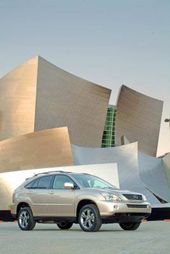
| ||
| LEXUS | ||
|
Toyota | Lexus | Scion | Hino | Daihatsu Current Cars: IS 250/250C/350 · IS-F · ES 350 · GS 300/430/450h · LS 460/460L · LS 600h/600hL · LFA · CT 200h SUVs: RX 330/350/400h · GX 460 · LX 470 · LX 570 Hybrid: RX 450h · GS 450h · LS 600h/600hL · HS 250h Historic Cars: IS 200/300 · ES 250/300/330 · GS 300/400/430 · LS 400/430 · SC 300/400/430 Hybrid: RX 400h Racing Vehicles Concept Vehicles LF-A Concept · LF-C Concept · LF-Ch Concept · LF-S Concept · LF-Sh Concept · LF-X Concept · LF-Xh Concept · IS 250 Sports Concept | ||
| Toyota | Corporate website | A division of the Toyota Motor Corporation |
References
<references /> This page uses content from Wikipedia; see Lexus, which includes these contributors.
External links
- Lexus.com - the official Lexus website
- Lexus Japan
- Lexus Europe
- Lexus UK Website
- Team Lexus - official webpage of the factory-backed team competing in the Grand American Cup road racing series.
- Lexus Magazine Website, featuring quarterly updates from the owners' publication
- Planet Lexus - Pictures and information regarding every Lexus model ever made
- ClubLexus - Lexus Enthusiast Website
- general information on Lexus
- Car Guys on plural of Lexus
- Lexus SC430 Pebble Beach Edition 2006
